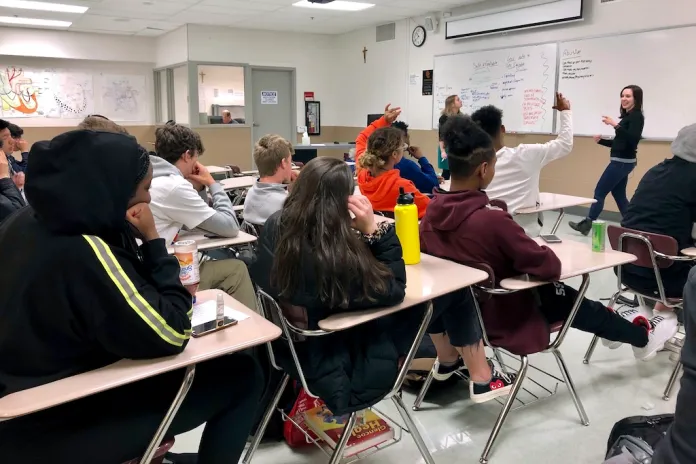Why Male Teachers Left Elementary Schools And Won’t Go Back
Teh article discusses the significant decline of men in American education, particularly in elementary teaching, where male teachers dropped from about 30% in 1970 to only 11% in 2021. This shift has created a gender imbalance that negatively impacts education. Men have not left voluntarily but were pushed out by the increasing feminization of schools, influenced by feminist ideology adn a female-dominated culture that many men find unappealing.
Despite criticisms that men avoid teaching due to pride or low pay, evidence shows that teacher salaries have increased when adjusted for inflation, and gender stereotypes were stronger in the past. Instead,men’s absence is attributed to the shift in school environments-from the stricter,discipline-focused schools of the 1970s to today’s nurturing,relaxed,and safety-oriented atmosphere that de-emphasizes standards and discipline.
Education schools themselves have become overwhelmingly female and left-leaning, further perpetuating the feminization trend. Though, all-boys’ schools that emphasize discipline, academic rigor, and physicality still attract many male teachers, illustrating that men seek meaningful missions they can believe in rather than just salary or status. The article argues that men are aware when they are not genuinely wanted in public elementary education and respond accordingly.
Men are disappearing from the education landscape in America. In 1970, about 30 percent of America’s elementary teachers were male; by 2021, the number had dipped to 11 percent. Similar or even steeper drops happened at middle and high school levels.
The absence of men creates a harmful imbalance in how America’s children are educated. Men, however, did not depart willingly. They were driven out by the increasing feminization of schools, producing a vicious cycle of female-dominated schools.
Many blame exodus on male pride. Education, especially elementary education, is, critics say, “female coded.” Teachers earn less. Jobs in elementary education are not thought to be masculine enough. “We need to break down the gender stereotypes preventing men entering these large, high-growth job sectors” like education, argues the Brookings Institution’s Richard Reeves and others.
Teachers, in fact, are paid more today than they were in 1970, in inflation-adjusted dollars. And “stereotypes” (if such they are) were arguably much stronger in 1970 than today.
Feminist ideology and the spiritual dominance of women (what author Helen Andrews calls “the great feminization”) in elementary education dissuades men from even considering work in elementary education. It turns out, not surprisingly, that men make rational decisions in the face of feminized institutions like elementary schools.
Schools in the Seventies
Picture schools in 1970. The idea of social promotion (where students would stay with peer groups and be promoted regardless of whether they had mastered material) was just catching on. As many as 5 percent of students were still held back in grades. Schools had clear rules and real consequences for violations. Public schools administered corporal punishment in 1970 — it was legal in 49 states (only New Jersey had banned it) and practiced in as many as 70 percent of school districts. Students would write “I will not talk in class” on the chalkboard 100 times for speaking out of turn, a punishment I was subjected to in the 1980s. Uniforms were common. Dangerous play happened at recess, as did many injuries, but was considered part of growing up. Drills, repetition, and rote memory were still common teaching practices. Students still got Cs (or, dare I say it, Ds and Fs) in 1970.
The 1990 movie “Kindergarten Cop,” where Arnold Schwarzenegger plays an FBI agent going undercover as a kindergarten teacher, captures this well. Arnold’s character emphasizes boot-camp discipline, marching in line, enforcing rules, and drills-based learning to the kids. His quaintly out-of-season methods make for laughs, as do the cute, politically incorrect things that the students say (several kids from the movie would, no doubt, be sent to sensitivity training today if they uttered the same things).
Feminization of Schools
Today’s schools emphasize belonging and nurturing at the expense of objective standards. Barely anyone is held back in today’s schools. Handing work in on time is increasingly optional. Fewer than 25 percent of students get grades below a B across the nation, though fewer than that read and do math at grade level. Even such loose grading, we are told, stigmatizes students too much. Teachers have difficulty maintaining classroom discipline. Uniforms are out, as is rote-learning or memorization. Safetyism dominates recess. Games and recess are monitored. Physical fitness was, until recently, not as important as kindness.
The healthy mix of nurturing from typically female teachers and male standard enforcement from kindergarten cops is a thing of the past. As a result, men are generally less interested in working in elementary education.
Influence of Education Schools
Education schools initiated this change in educational outlook. In 1970, around 65 percent of the faculty in schools of education were male. By 2021, the number is substantially lower.
Faculty for elementary education majors are even more overwhelmingly female and leftist. Among the 15 Southeastern Conference schools of education with elementary education majors, 28 percent of the elementary education faculty are males (80 out of 285). Twenty-six percent of the elementary education faculty are males in the 18 Big Ten schools (88 out of 340). In Texas, 26 percent of the 660 faculty affiliated with the state’s 33 elementary education programs are males. Twenty-six percent of the faculty affiliated with Idaho’s elementary programs are male as well.
Elementary teaching is not coded female in the nature of things; it has become dominated by an ethos from a particular kind of female.
Elementary schools outside the normal certification process still recruit men to teach young boys. All-boys’ schools with an emphasis on discipline, academic standards, and physicality attract male teachers even in elementary schools. Four of the top five largest all-boys’ private schools in the country have faculties that are more than 75 percent male (Haverford School in Pennsylvania; St. Mark’s School of Texas in Dallas; and The Browning School and Allen-Stevenson School in New York City). This is typical, of course. Men are interested in raising honorable, self-controlled boys into men. Schools that infantilize boys do not interest male teachers.
Men do not simply want enough money or prestige from their jobs. They want missions they can believe in. Today’s public elementary schools fail that threshold question — efforts to recruit and advertise do not address why men have left public elementary school teaching. Men should be given enough credit to know where they are not wanted.
Scott Yenor is director of the B. Kenneth Simon Center for American Studies at the Heritage Foundation and Washington Fellow at the Claremont Institute’s Center for the American Way of Life.
" Conservative News Daily does not always share or support the views and opinions expressed here; they are just those of the writer."




